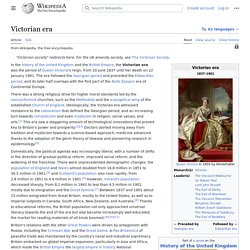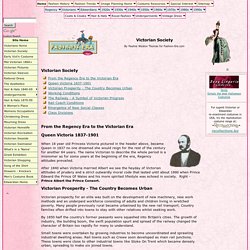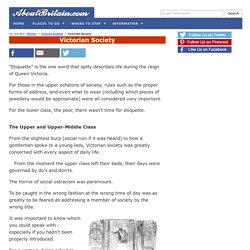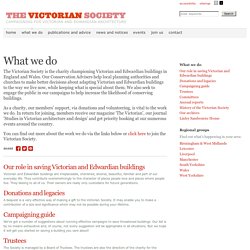

The Victorian Society. Victorian era. Period of British history encompassing Queen Victoria's reign Ideologically, the Victorian era witnessed resistance to the rationalism that defined the Georgian period and an increasing turn towards romanticism and even mysticism with regard to religion, social values, and arts.[2] Terminology and periodisation In the strictest sense, the Victorian era covers the duration of Victoria's reign as Queen of the United Kingdom of Great Britain and Ireland, from her accession on 20 June 1837—after the death of her uncle, William IV—until her death on 22 January 1901, after which she was succeeded by her eldest son, Edward VII.

Her reign lasted for 63 years and seven months, a longer period than any of her predecessors. Political and diplomatic history Early In 1832, after much political agitation, the Reform Act was passed on the third attempt. Middle Society and culture Evangelicals, utilitarians, and reform Religion Status of Nonconformist churches Agnostics and freethinkers Family and gender roles. Characteristics of Victorian Era Society. The Victorian era in comparison to today’s times was extremely strict.

Even their view of behavior had many things different than today. Things as little as a man sitting down before women just prior to eating was considered extremely rude. In a time today where I frequently sit at the table with a hat on, it was inappropriate for men to even sit down at a table with gloves on, much less leaving a hat and gloves on for an entire meal. The ladies did not have a much easier time. If they used an older mans first name this was considered inappropriate and a lack of respect. The way that society dressed also showed how strict they were. Even though society as a whole would be viewed as very conservative, the era was actually a very progressive era. Another thing that this society began to put value in was education. However, by the end the term gentlemen were also associated with the men who had received good educations. Victorian Society - History 1837 to 1901.
Victorian Society From the Regency Era to the Victorian Era Queen Victoria 1837-1901 When 18 year old Princess Victoria pictured in the header above, became Queen in 1837 no one dreamed she would reign for the rest of the century for another 64 years.

The name Victorian to describe the whole period is a misnomer as for some years at the beginning of the era, Regency attitudes prevailed. After 1840 when Victoria married Albert we see the heyday of Victorian attitudes of prudery and a strict outwardly moral code that lasted until about 1890 when Prince Edward the Prince Of Wales and his more spirited lifestyle was echoed in society. Victorian Prosperity - The Country Becomes Urban Victorian prosperity for an elite was built on the development of new machinery, new work methods and an underpaid workforce consisting of adults and children living in wretched poverty. By 1850 half the country's former peasants were squashed into Britain's cities. Working Conditions Rail Coach Conditions --Link-- Victorian Society on AboutBritain.com. "Etiquette" is the one word that aptly describes life during the reign of Queen Victoria.

For those in the upper echelons of society, rules such as the proper forms of address, and even what to wear (including which pieces of jewellery would be appropriate) were all considered very important. For the lower class, the poor, there wasn't time for etiquette. The Upper and Upper-Middle Class From the slightest burp (social ruin if it was heard) to how a gentleman spoke to a young lady, Victorian society was greatly concerned with every aspect of daily life. From the moment the upper class left their beds, their days were governed by do's and don'ts.
The horror of social ostracism was paramount. To be caught in the wrong fashion at the wrong time of day was as greatly to be feared as addressing a member of society by the wrong title. It was important to know whom you could speak with - especially if you hadn't been properly introduced. Young ladies were constantly chaperoned. What we do - The Victorian Society. The Victorian Society is the charity championing Victorian and Edwardian buildings in England and Wales.

Our Conservation Advisers help local planning authorities and churches to make better decisions about adapting Victorian and Edwardian buildings to the way we live now, while keeping what is special about them. We also seek to engage the public in our campaigns to help increase the likelihood of conserving buildings. As a charity, our members’ support, via donations and volunteering, is vital to the work we do. In return for joining, members receive our magazine ‘The Victorian’, our journal 'Studies in Victorian architecture and design' and get priority booking at our numerous events around the country.
The Victorian Society.